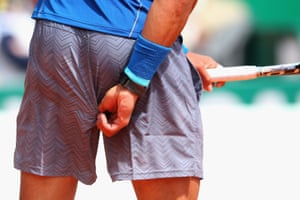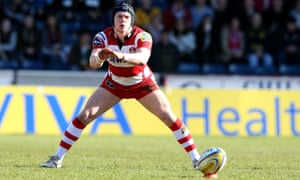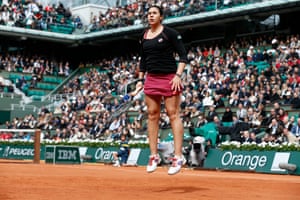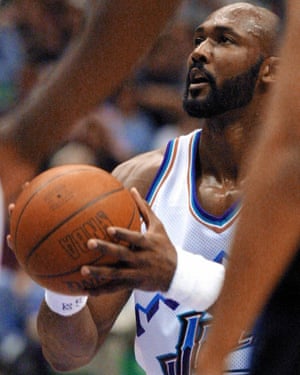From Rafael Nadals plucky pre-serve shorts act to the superhero stance of Gloucesters Rob Cook, players would rather risk ridicule than change routines

1) Nadal and his shorts
If there is a single episode that fully captures the essence of Andy Murrays weird and wonderful eccentricities, it is probably the time when he suffered several shorts malfunction during his victory over Marcos Baghdatis at Wimbledon in 2012 and lost two points after tennis balls kept falling out of his pockets during rallies, like a down on his luck magician who couldnt stop the dove from slipping out of his sleeve. It felt like it was always about to happen Murray said. It lost me two points.
Yet while the sartorially challenged Scot volleyed a barb at the depth of his pockets, Rafael Nadal took a different approach when he was asked about his odd little habit of tugging at his shorts before a serve in 2010. Its not the fault of the clothes, Nadal said. Its a habit that I picked up when I was competing when I was young. I am trying to break the habit, but its not easy. After all, what is Nadal supposed to do? Tie his hands together? Rub chilli powder on the back of his shorts? Ditch them altogether?
With no one able to offer a viable solution, Nadal has been unable to shake the short tugging addiction that has made his pre-serve routine one of the stranger sights on the mens tour and, indeed, helping him to unsettle and fluster his opponents by keeping them waiting for as long as possible up the other end of the court. Bounce, bounce, bounce. Scratch, scratch, scratch. Bounce, bounce, bounce. Scratch, scratch, scratch. Bounce, bounce. Scratch, scratch. Bouncy, bounce. Scratchy, scratch. Bounce. Scratch. Scratch. Bounce. Man, Nadals uncle Toni said in 2012. At first I didnt mind, but a player who puts bottles and not step lines is obsessive. Once he told me about a movie, As Good As It Gets How superstitious the main character was! And I said, Hes like you. And he replied: No, no.

When you do senseless things over and over, youre superstitious. He has told me before he can stop doing them and I have told him to do it. I like things that are logical. It does not affect his game, but if he needed those things to play well, it would be bad.
Few players bring as much superstition to the court as Nadal, whose quirks range from jumping while at the net during the coin toss and going to the towel after every point to running to the baseline before knocking up and crossing the line only with his right foot.
But there are ways to get inside his head. After following a swig from his recovery drink with a sip of water always in that order Nadal is meticulous in the placement of both bottles near his chair, which is why Lukas Rosol knew exactly what he was doing when he knocked one over with his racket during their match at Wimbledon in 2014. Not that it did Rosol much good. Nadal still romped to victory. JS
2) The Junaid Jump
There are many bowlers with quirks at the start of their run-up like Morne Morkel, whose run-up essentially begins with him facing in the wrong direction, from where he spins and sets off. Other run-ups have unusual ends, like the former West Indies quick Colin Croft, who would run in a straight line towards the stumps, almost hiding from the batsmans view behind the umpire, before leaping suddenly to one side just before he released the ball. Nobody taught me how to bowl, he said. I bowled because I was comfortable and confident and at ease and natural. It must have given me an advantage it gave me 125 wickets in 27 Tests.
It is rare, however, to have weird anomalies in the middle. Theres the Harbhajan Singh spreadeagle, of course, which involves the spinner decorating his short run-up by momentarily stretching his arms wide as if considering flight, before tucking them in again and delivering the ball, but none could be more remarkable than the Junaid Jump, as practised by the 26-year-old Pakistan bowler Junaid Khan. About a quarter of the way through his run-up Junaid would leap in the air like a spring lamb, before carrying on as if nothing had happened, picking up pace on his way to the wicket. I feel it gives me momentum, he told PakPassion.net. Its like a car changing gear, I feel I am changing gear in my run-up after the jump. I start my run-up slowly, then change gear after my jump.
In another interview he explained the genesis of the jump, which he first introduced while playing for Water and Power Development Agency against Fort Qasim in a Pakistani domestic game. It was a flat wicket and Khalid Latif and Umar Amin were batting on and on, he said. With no clear idea, I just took a jump before the run up, hoping to psyche out the batsman, and it so happened that I got him out that very ball. It was an excellent delivery. Then the same thing happened in another game. So it became part of my run-up, to a point where it felt like without the jump I wasnt bowling as well.
While audiences thrilled to Junaids idiosyncrasy, it didnt exactly please the games classicists, or for that matter the players coaches. When I try to stop doing the jump, I feel I cant even bowl properly, he said. My run-up and rhythm are all over the place without it. Some senior players told me to jump, others said dont jump. Some senior players advised me that we play most of our games in the UAE where the ground is softer because of the sand, and so the jump puts more strain on you, theres more of a risk of injury. Mohammad Akram [then coach of the Pakistan National Cricket Academy] said to me that if the jump helps with the rhythm, then I should continue jumping.
The doom-mongers, it turned out, had a point. In October 2014 he twisted his knee, and soon afterwards suffered a grade three osteochondral fracture, also to his knee. He was out for nearly eight months, and by the time he came back the jump was gone. I had to stop because we play a lot of games here in Dubai and Sharjah where the ground is very soft, he said. With all the body weight concentrated on the legs during the jump, the risk of injury increases. So, it just had to go.
Some of Junaids mojo seems to have gone with it. In 18 Tests before his injury he took 65 wickets at an average of 28.83; in four Tests since he has taken six wickets at an average of 63.16. He has not played for his country in any format since last June, and it looks increasingly like even if he is selected in the touring party the Junaid Jump will be sadly absent from Pakistans tour of England this summer. SB

3) Cooks pre-kick caper
The first noble truth of rugby is: suffering exists. The second is: cauliflower ears, broken bones and bleeding eyes can be transcended. The third is: people will claim that beer helps. The fourth is: miss that penalty and youll feel like a pillock. Its a harsh sport, all right, and kickers know that better than most. Because in addition to physical pain, they are exposed to a level of spiritual torment that drives some of them to self-flagellation or, at least, to ghastly uncomfortable pre-kick rituals. Were not talking Owen Farrells laser-eye routine here, nor even Dan Biggars fidgety jig, we mean the deliberate adoption of a stance so awkward that onlookers are not sure whether the kicker is bravely shattering convention in the pursuit of perfection or is simply inviting ridicule as a way of steeling himself for the abuse hell get if he misses.
Jonny Wilkinson introduced us to the sight of a man preparing for a kick in the same way he might prepare for an on-toilet prayer, crouching down and clasping his hands in front of his chest as he aimed for heaven. And Gloucesters Rob Cook, alone in the world, reckoned that stance was not quite awkward enough. He figured the crouching was good but the arms should be outstretched in the manner of Superman in full-flight and the legs should not be together but splayed as wide as possible as if attempting to straddle two horses at once. And the weirdest thing is it works: the joy of landing a kick successfully is augmented by the pleasure of silencing all the cat-callers and wolf-whistlers. Until the next time. PD

4) Bartolis shadow boxing
When they are receiving serve, most tennis players simply walk to the back of the court, ready themselves, try to work out where their opponent is going to opponent aim next, crouch down and wait for the ball to fizz over the net. But Marion Bartoli was different. Tennis players practise for hours, going through the same drills, straining to perfect the same shots, looking to hit the same sweet spots with unrelenting accuracy, and the countless hours spent honing their games mean they go into matches knowing nothing has been left to chance. Some of them reckon, for instance, that the brief knock-up with their opponent before the umpire calls time is a pointless waste of energy. A person can only do so much revision. Yet Bartoli was different. In the moments before her opponents serve, she would take the opportunity to go through the tennis equivalent of shadow boxing, bouncing around the court and swinging through a number of imaginary balls. It is what part of what made the enigmatic Frenchwoman so interesting to watch. When she served, she bounced the ball at a level that would shame Lisa Simpson and her swing was so exaggerated it looked like she was playing it for laughs. Yet after years of falling short, Bartoli won her first grand slam at the age of 28, beating an emotional Sabine Lisicki in the Wimbledon final in 2013. Practice makes perfect. JS

5) The Malone Mumble
Theres a lovely old video on YouTube of Rick Barry explaining his free throw routine. Barrys free throws were unusual, in that he used the outdated and wildly unfashionable underhand throwing technique, sometimes referred to as granny-style, which Wilt Chamberlain, a notoriously unreliable free throw exponent, tried and abandoned despite its positive effect on his averages on the grounds that it made him feel silly, like a sissy. I like to bounce the ball three times, Barry explains in the video. Why three, he is asked? Well, I just got in the habit of doing it three times, and I just do it the same way.
With the free throw, everyones got a habit, a ritual that probably falls somewhere between a conscious tic and a superstition. Some are just more unusual than others, and Karl Malones perhaps the most unusual of all, as he bounced the ball a few times, tossed is in the air twice, and then spent a few seconds mumbling unintelligibly. A lip-reader at one point announced that he was saying, this is for Karl, Karl, my baby boy, which may sound like a strange way for a man to refer to himself, but Malone does indeed have a son with the same name as himself as well as three daughters, Kadee, Kylee and Karlee though the player insisted he would say different things on different occasions. Whatever he said, it worked before he discovered mumbling he converted an underwhelming 54.8% of his free throws, afterwards it rocketed to 75.7%, and he made more free throws than anyone else in NBA history (albeit having attempted more than 2,000 more than his nearest rival). SB

6) Breess finger licking good
Quarterbacks in the NFL licking their fingers is nothing new and whether it adds to their ability to grip a football, or simply makes them think it does, amounts to more or less the same thing. There are others who do it as a code, a sign as to the play theyre about to run similarly, in baseball, a pitcher might alert his catcher as to what hes about to throw with a couple of quick licks. But then theres the New Orleans Saints Drew Brees, a man who more or less dines out on his digits several hundred times a game. Lick, lick, lick, throw. Lick, lick. Lick. Throw. Lick, lick, lick. Its not just when hes on the field. Last September the Saints played without the injured Brees for the first time in virtually a decade, leaving the quarterback to follow the match from the sideline. Every time the huddle broke, Brees would rub his hands, clap them, then lick his hands just the same as if he was actually in the game. With finger licking that good, surely it is only a matter of time before Kentucky Fried Chicken comes calling. TB
Read more: www.theguardian.com









![[Video] How to get rid of bed bugs in Toronto](https://www.thehowtozone.com/wp-content/uploads/2019/10/maxresdefault-2-100x70.jpg)


